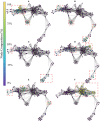Interpreting Deep Learning Features for Myoelectric Control: A Comparison With Handcrafted Features
- PMID: 32195238
- PMCID: PMC7063031
- DOI: 10.3389/fbioe.2020.00158
Interpreting Deep Learning Features for Myoelectric Control: A Comparison With Handcrafted Features
Abstract
Existing research on myoelectric control systems primarily focuses on extracting discriminative characteristics of the electromyographic (EMG) signal by designing handcrafted features. Recently, however, deep learning techniques have been applied to the challenging task of EMG-based gesture recognition. The adoption of these techniques slowly shifts the focus from feature engineering to feature learning. Nevertheless, the black-box nature of deep learning makes it hard to understand the type of information learned by the network and how it relates to handcrafted features. Additionally, due to the high variability in EMG recordings between participants, deep features tend to generalize poorly across subjects using standard training methods. Consequently, this work introduces a new multi-domain learning algorithm, named ADANN (Adaptive Domain Adversarial Neural Network), which significantly enhances (p = 0.00004) inter-subject classification accuracy by an average of 19.40% compared to standard training. Using ADANN-generated features, this work provides the first topological data analysis of EMG-based gesture recognition for the characterization of the information encoded within a deep network, using handcrafted features as landmarks. This analysis reveals that handcrafted features and the learned features (in the earlier layers) both try to discriminate between all gestures, but do not encode the same information to do so. In the later layers, the learned features are inclined to instead adopt a one-vs.-all strategy for a given class. Furthermore, by using convolutional network visualization techniques, it is revealed that learned features actually tend to ignore the most activated channel during contraction, which is in stark contrast with the prevalence of handcrafted features designed to capture amplitude information. Overall, this work paves the way for hybrid feature sets by providing a clear guideline of complementary information encoded within learned and handcrafted features.
Keywords: CNN; ConvNet; EMG; Grad-CAM; MAPPER; deep learning; feature extraction; gesture recognition.
Copyright © 2020 Côté-Allard, Campbell, Phinyomark, Laviolette, Gosselin and Scheme.
Figures












References
-
- Ajakan H., Germain P., Larochelle H., Laviolette F., Marchand M. (2014). Domain-adversarial neural networks. arXiv [Preprint] arxiv:1412.4446.
-
- Allard U. C., Nougarou F., Fall C. L., Giguère P., Gosselin C., Laviolette F., et al. (2016). A convolutional neural network for robotic arm guidance using SEMG based frequency-features, in 2016 IEEE/RSJ International Conference on Intelligent Robots and Systems (IROS) (Seoul: IEEE; ), 2464–2470.
-
- Alom M. Z., Taha T. M., Yakopcic C., Westberg S., Sidike P., Nasrin M. S., et al. (2018). The history began from alexnet: a comprehensive survey on deep learning approaches. arXiv [Preprint] arxiv:1803.01164.

